The Official IC Fashion Forum Suits Thread
Options
Comments
-
The Men’s Suit: The Suit Jacket Completed
With an introduction of the men’s suit jacket successfully behind us, as well as a more detailed men’s suit discussion, it is now the time to complete our examination of the elements of the suit jacket. With a firm grasp of the elements that make up the core of the jacket, we can now look into the details that transform a jacket from ordinary clothing into a distinctive and individual feature of the wardrobe.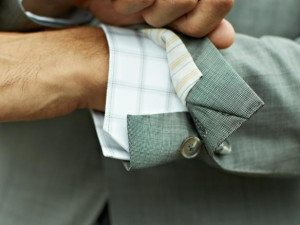
Jacket Sleeve Buttons
There are numerous historical reasons for jacket sleeves bearing buttons, from encouraging the use of handkerchiefs to allowing a gentleman to wash his hands without removing his jacket, a traditionally grave social offense in mixed company. Whatever the reason for their arrival on jacket sleeves, they now form an important part of the detail work or trimming of the jacket. Most traditionally, men’s suit jacket sleeves bear four buttons, though it is not uncommon to find three. Regardless of number, they should always match the waist buttons, and are always placed within a half-inch or so of the hem. On bespoke suits, and even some of the higher-quality made-to-measure jackets, the sleeve buttons are functional, though there is little reason to ever use them – rather, it is a subtle declaration of the jacket’s quality. When the buttons are functional, there is some temptation to leave one button undone in order to draw attention to the feature – and by extension, the quality of the men’s suit – though this is a matter of personal taste.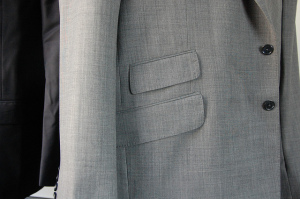
Men’s Suit Jacket Pockets
Moving on from the jacket sleeves, we have the pockets, which present a variety of options, all at differing levels of formality. The most formal are jetted pockets, where the pocket is sewn into the lining of the jacket and only a narrow horizontal opening appears on the side of the suit jacket. These pockets, being nearly invisible, contribute to a very sleek, polished appearance, and are most frequently found on formal-wear. The next style, the flap pocket, is slightly less formal, though it is perfectly acceptable in all the circumstances where a gentleman is likely to be found in a men’s suit. Flap pockets are made identically to jetted pockets, but include a flap sewn into the top of the pocket, which covers the pocket’s opening. These are the most common pockets on men’s suit jackets, and in the very best, are fabricated so that the wearer may tuck the ? inside, mimicking the jetted pocket. There are also diagonally-cut flap pockets known as hacking pockets, though they are somewhat less common; the hacking pocket is derived from English riding gear, and is most prominent on bespoke suits from English tailors, particularly those traditionally associated with riding clothes. The least formal are patch pockets, which are exactly what the name implies: pockets created by applying a patch to the outside of the jacket. Patch pockets are the most casual option; they are frequently found on summer suits that would otherwise appear overly formal, as well as on sports jackets.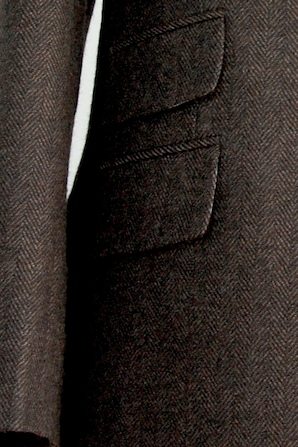
On the subject of pockets and things the conscientious wearer avoids, there are a few guidelines for utilizing the pockets on suit jackets. While the outside pockets on most jackets are functional, placing large bulky items – including the hands – in these pockets will distort the silhouette of the jacket. Keys and other sharp objects should be kept away from the jacket pockets, as they can damage the lining, leaving holes into which small objects are invariably drawn. Many jackets come with the pockets sewn shut, and while it is generally better to open them, those who have difficulty remembering what to avoid may find it beneficial to leave them unopened. The side pockets are not the only pockets on the jacket, however. Some men’s suit jackets, particularly bespoke and finer made-to-measure offerings, include a small ticket pocket (http://www.realmenrealstyle.com/ticket-pocket/) above one of the side pockets, generally on the same side as the wearer’s dominant hand. This pocket is rarely used in modern times, and serves more as an indication of the suit’s quality. Moving up the jacket is the breast pocket, which is always open, and into which only one item is ever placed: the handkerchief or pocket square. The reason for this is twofold: First, like the side pockets, any items placed in the breast pocket create lumpy projections which distort the sleek appearance of the suit, and second, the breast pocket and the inside left pocket share the same space in the jacket’s lining, meaning that objects in the breast pocket tend to force items in the inside pocket into the wearer’s ribs, which is quite uncomfortable.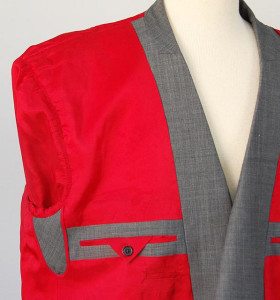
Inside pockets vary greatly, with some jackets having only one, usually on the left, though it is more common to have pockets on both sides. These pockets are generally large enough to carry a checkbook-sized wallet or card case, as well as a pen and perhaps tickets or other similar papers, though one should be careful, as bulky items, even in the inside pockets, can distort the jacket’s appearance. On bespoke suits, the options for pockets are only limited by the wearer’s imagination, as a good tailor can create specialty pockets sized to hold a variety of useful items. In today’s world of technology, such pockets provide the perfect place to store items like cell phones and iPods.
-
The Men’s Suit: The Suit Jacket Completed Pt. II
https://www.youtube.com/watch?v=U2Fi-Cl0ESo
Suit Jacket Vents - Which Style For Which Body Type - Single Vent - Double Vent - No Vent Jackets
Jacket Vents
Moving on from pockets we find the vents, flap-like slits in the bottom of the jacket which accommodate movement and offer easy access to the trouser pockets. Men’s suit jackets have three styles: center, side, or none. Ventless suit jackets, just as the name implies, have no vents, and are popular on Continental suits; they provide a very sleek look to the back of the jacket, though they can lead to wrinkling when the wearer sits down. Center-vented jackets, very popular on American suits, have a single slit at the back, allowing the jacket to expand at the bottom when sitting. Because of its placement, center-vented jackets have a habit of exposing the wearer’s posterior, though most seem not to mind, as center vents remain the most popular style. A side-vented jacket has two vents, one on either side, generally just behind the trouser pockets, to provide easy access. Side vents also facilitate sitting more easily, moving as needed to prevent the rumpling of the jacket back, which leads to creasing.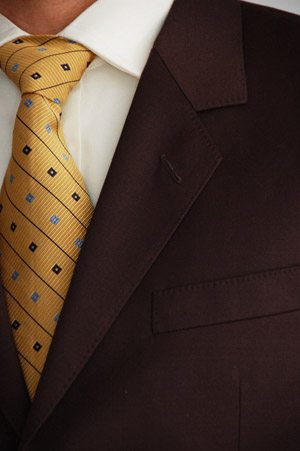
Lapel Button Hole
A last bit of trimming concerns the lapels. Most jacket lapels include a button hole on the left lapel, roughly an inch below the gorge, which is generally sewn shut. On very high quality jackets, there will be a corresponding button on the right lapel, though this is merely an element of style, as the lapels of a suit jacket are never turned up in the manner of a military uniform. On most any suit, the buttonhole can be opened, and on the very best, there will be a small fabric loop on the underside of the left lapel, just below the buttonhole. This is to facilitate the boutonnière, a small flower worn on the lapel, though the practice is generally confined to important participants in special occasions, e.g. the groom and groomsmen at a wedding or dignitaries at a memorial service. Anyone choosing to wear a boutonnière on a regular basis is making a bold-yet-elegant choice.
Thus we finish our study of the suit jacket, though there is still a great deal to be learned about suit color, suit pattern, suit fabric, all of which we shall address in their own in-depth discussions.
-
Maximus Rex wrote: »what brands should i be looking at for the best quality in the $200-500 range?
When you're talking suits, it isn't about the "brand," per se. in my opinion. When you start looking at the brand, that's going to drive the price up. Also, in your price range, you're going to be buying off-the-rack, which means you're going to be taking in to a tailor or seamstress to have the suit adjusted and altered anyway.
If you can spend $500, I'd strongly suggest that you save another $200 and go to a made-to-measure place like http://mysuitny.com/website/default.aspx, they'll make you some ? . Or someplace like http://us.suitsupply.com/en_US/home or an old standby like Brooks Brothers. If those place ares too pricey for you try Jos. Banks or MenWearhouse, but only as a last resort.
From what i read, those places offer low quality suits
From Dappered.com, one of the sites I frequent...Suitsupply “Blue Line”, with it’s half-canvas construction, Italian wools, and attention to detail is a lot of suit for just under $400. Throw in free shipping and free returns and you’ve got a line of suits that has to be the first stop for most looking to add to, or start a collection of sharp suits.
.... for just a bit more than a rarely on sale Banana Republic fused suit, you can get something that’s quite a bit farther along in terms of quality. -
A Man and the Double Breasted Suit Jacket
http://www.atailoredsuit.com/mens-double-breasted-suit-jacket.html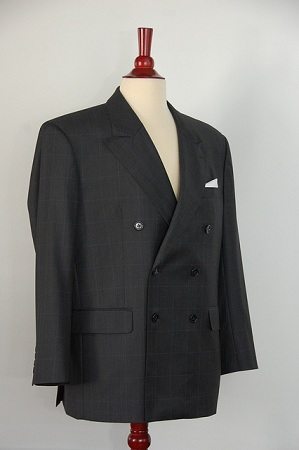
Every coat that has a collar and lapels, whether sport coat, suit jacket, or overcoat, is either single-breasted or double-breasted. The single-breasted construction is much more common, and consists of buttons on one edge and button holes on the other, meeting in a vertical line over the navel. The double-breasted coat bears symmetrical sets of buttons on each side, with the left side folding over the right to be secured by one or two of them. Single-breasted jackets are easy to find and look good on just about everyone. Whether blazer or suit jacket, it can be made with two or three buttons, wide or narrow lapels, and high or low gorge, according to the particular needs of one’s body. For every man, there is a single-breasted configuration that is guaranteed to look handsome. For this reason, the model as it has evolved over two-hundred years today holds the center-place of men’s style.
While the double-breasted coat demands a greater investment of time and effort to acquire and wear successfully, for many men the payoff is fantastic.
Since every man will own some single-breasted jackets and suits, the question of single or double-breasted is really a question of double-breasted or not. First, I shall consider its drawbacks; for those who remain undeterred I shall then recount its glories.
Reasons to Pass on a Double Breasted Jacket
With an extra layer of fabric across the front and two rows of buttons, the double-breasted jacket is enough to drown a smaller man’s frame. Those of narrow torso and shoulders will find it covers almost their entire chest, barely allowing the shirt and tie a glimpse of daylight. Neither is it friendly to short men, as its bulk can diminish height.
The double-breasted suit is also more formal than the single-breasted, and is therefore less versatile. It is anachronistic over anything other than a conservative dress shirt and neck tie. It looks ridiculous unbuttoned, and must therefore always stay closed, and this combined with its double-ply front can make it uncomfortable in the heat. Finally, double-breasted suits have waned in popularity over the past half-century, and it is therefore quite difficult to find one that fits correctly.
Reasons to Choose a Double Breasted Jacket
Nevertheless, for the man who can wear it, the double-breasted suit provides a rare opportunity to don a more stylish garment without attracting undue attention. To the casual observer a double-breasted suit differs little from a single-breasted one, but on closer examination it yields an older, more elegant look. While it is indeed hard for most men to find one that looks really superb, when custom made its length, gorge height, button stance and lapel roll may each be selected to amplify a body’s virtues and distract from any shortcomings.
The double-breasted coat always sports peak lapels, and these contribute to its superior refinement. The original style has six buttons, with two to close. While this suits tall men well, shorter men do better with a four- or six-button configuration in which only the bottom one closes (the four-button double-breasted jacket is sometimes called the “Kent,” after it’s supposed inventor the Duke of Kent). The long, diagonal lines of lapels rolling to below the waist give the impression of height and downplay width. Indeed, a well-cut double-breasted jacket minimizes girth on all portly men, especially if it has broad shoulders to drape from.
The Double Breasted Suit and Accessories
The accessory rules when wearing a double-breasted suit are very similar to single-breasted suits. When it comes to neckwear, either a bow tie or neck tie can be worn. However, the presence of no neckwear whatsoever is a definite style blunder, as that the double-breasted jacket’s formality by default demands something to adorn the neck. A necktie’s width has always been determined by the jacket’s lapel, although with the double breasted jacket this can be difficult when they are wider than four and a half inches. Average lapel widths range from 3.375 inches to 4.25 inches, with most double-breasted coat lapels leaning towards the later.
A necktie within the width range of 4 inches is always a safe bet. More important than the width of the necktie however is the tie’s knot; with 70% of the tie hidden under a buttoned jacket, the knot takes center stage. Be sure to pay attention when you compress the knot to form a strong inverted “V”. With the tie knot’s proximity so close to your face, a blunder here will surely not go unnoticed. Finally, carefully choose a pocket handkerchief that conveys the message you wish to send. With little shirt and tie showing, the breast pocket handkerchief will have a stronger effect than when it is worn with a single-breasted jacket.
For men who are tall, broad-shouldered, or both, the double-breasted suit is a boon to the wardrobe. The double-breasted blazer, too, is a brilliant way to do casual with flair. While every man will own and wear single-breasted jackets, going double-breasted provides a special opportunity to broaden one’s sartorial horizons without straying from tradition.https://www.youtube.com/watch?v=U2Fi-Cl0ESo
Suit Jacket Vents - Which Style For Which Body Type - Single Vent - Double Vent - No Vent Jackets -
Help a young brother out with the business casual look. I just went corporate so i need an entirely new wardrobe.
-
GOAT thread
t/s put in some serious work -
Thereal_ba wrote: »Help a young brother out with the business casual look. I just went corporate so i need an entirely new wardrobe.
Props on the new gig brotha. Id start off with slacks/chinos:
Black, blue, khaki, and gray
And Oxford (button up) shirts.
White and blue are must haves. But get down other colors and patterns.
http://dappered.com/2015/01/the-top-10-types-of-dress-shirts-to-own/
A pair of brown wingtips + matching belt
And a pair of black oxfords + black leather belt
Then cop u some sport coats/ Blazers to throw on when air gets cool.
Navy blue (spend more on this one)
Khaki/brown
And gray
Cop that and you'll be set w the basics for the office -
Nice thread bro...
-
http://www.realmenrealstyle.com/wp-content/uploads/2016/03/5-Tips-To-Wear-A-Suit-Without-A-Tie-tall.jpg
http://www.realmenrealstyle.com/suit-no-tie/
You look at yourself in the mirror.
Suit looks great.
Shirt looks awesome.
Now the question…
Tie? Or no tie?
It’s a harder question than it seems.
Everyone else will be wearing one.
But you’re not a tie guy.
And does your shirt collar really look great going tieless?
Gentleman, in today’s article, I am going to address those questions.
In addition, I am going to give you 5 points on how to wear a suit, sports coat, and blazer without a tie and look like a million bucks.
Note: For this article, I am going to use the terms jacket, sport coat, blazer and suit interchangeably.
A suit is when a jacket and trousers are made of the same fabric. Many modern gentlemen are wearing sports coats or blazers and generally the rules still apply.https://www.youtube.com/watch?v=NssjTpwmgJ0
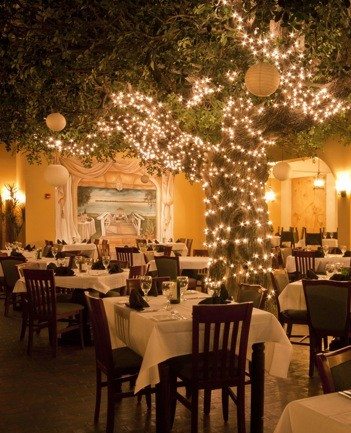
#1 The Proper Environment
An accurate environment is everything.
Certain environments require certain aesthetics. Choosing to not wear a necktie might not be viewed favorably and could have a severe penalty. For example, certain high-end restaurants require a jacket and tie or your work environment might dictate that the necessary uniform requires neckwear. Think about the situation.
In any case, make sure to research where you are going before you get there. Be thorough and exhaustive because sticking out like a sore thumb because you’re not in the proper attire would be beyond embarrassing.
If you research and do not get a clear answer and you don’t want to wear a tie, do it with confidence. What’s going to translate to others in that particular establishment is the moxie…the savoir-faire that you portray. Own that you are a metropolitan style savant who is not afraid to make his own statement and not have his contemporary flare boxed in. Many times confidence is seen more clearly than any garment you’re wearing.
#2 The Collar Is Key
Without a necktie, your collar is what frames your face. It helps give definition to your chin and neckline. What’s going to help make this frame is the placket of the shirt. I go into more detail here but the simple definition of a placket is the panel where the buttons and button holes are located.
As our friends over at Million Dollar Collar point out, the placket of a dress shirt is not strong enough to sustain the weight of the collar. So the result is a gaping, flimsy collar that doesn’t look crisp or adequately frame your face. They’ve developed a permanent way to reinforce the placket so that the collar flop doesn’t happen.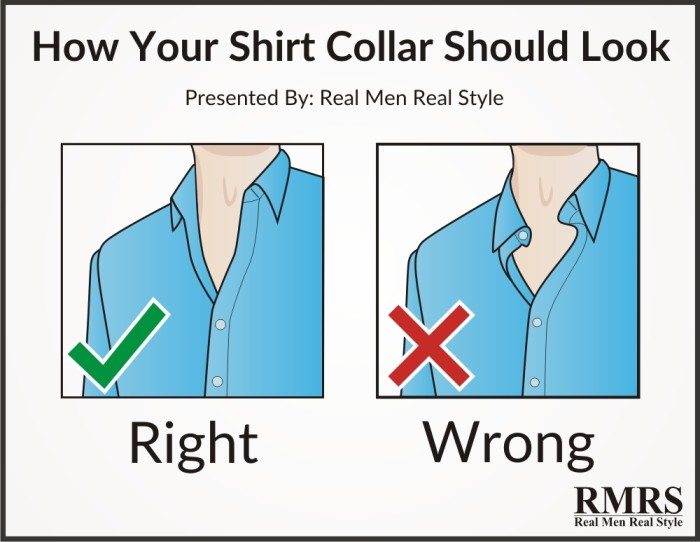
realmenrealstyle.com/dress-shirt-collar-infographic/
After you solve the placket issue, it’s on to the collar. Ways to make the color taut are:
- Make sure it’s ironed – This should be a no-brainer but you’d be surprised. Don’t be afraid to add some spray starch to the collar before ironing to give it some extra rigor.
- Put removable plastic, metal or magnetic collar stays in the collar.
- If possible, budget in dry cleaning and get your shirts lightly or heavily starched.
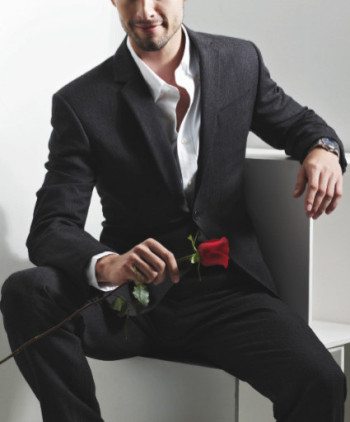
#3 One Or Two Button Drop?
Since the shirt is not bound by a tie you’re going unbutton the buttons of the shirt. It’s really preferential how many you should unbutton and there are few things to consider before making that decision. It comes down to your confidence level. Points to keep in mind are:
- The message it will send. If you the more buttons you have unbuttoned, the more casual and daring the look will be. You want to be mindful of your environment, audience and the overall mood of the scene.
- The amount of buttons that are on your jacket. If your jacket has more buttons, it’s going to squeeze the shirt together tighter so the shirt’s opening will be closed and look less casual. This is the result of the high button keeping the lapels of the jacket close together and the stiff collar is leaning on those lapels. Conversely, if you are wearing a 1 or 2 button jacket, the opening of the shirt will be wider – giving a more casual look.
#4 Keep Your Undershirt Hidden
Undershirts are important because they can:- Insulate you
- Protect the over shirt from body oils a and
- Help smooth the torso for a better fitting shirt
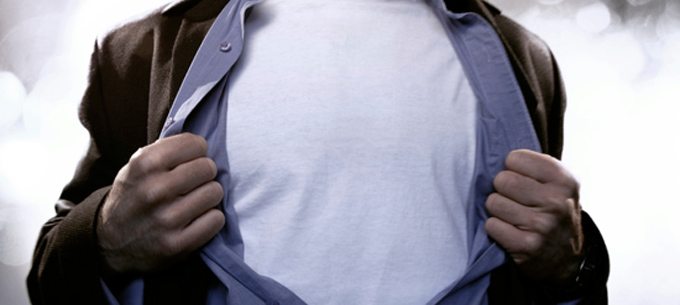
The general convention for wearing an undershirt is for it to not be seen. Remember that the open collar helps to frame your face and keep everything looking as streamlined and sleek as possible. Wearing the wrong type of undershirt can crowd the neck and give a bulky illusion. For this reason, wear a v-neck undershirt instead of a crew neck undershirt. The drop of the collar on a v-neck undershirt is perfect for maintaining that polished look.
Note: I am an advocate of trimming and controlling your chest hair. Again, this is totally up to you and based on your comfort level. In my opinion, this step is critical when exposing your neckline. Shaving completely is not necessary, but I recommend keeping it under control.
-
5 Tips to Wear a Suit Without a Tie Pt. II
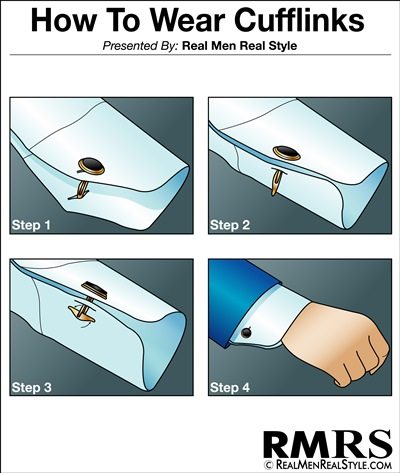
#5 Focus On Your Other Accessories
The necktie is an accessory that draws the eye in; it’s a focal point. Without the tie, your other accessories become more important. Your accessories such as
- Pocket square – As a generalization, the eyes draw to the face then downward. As such the pocket square is vital to keep the tieless suit as refined as possible. Many gents forego this critical accessory because they simply don’t know how to sport it. It’s really simple. Just get a plain white kerchief or pocket square, make a straight fold, and place it in your pocket with about ¼ to ½ an inch of the pocket square exposed. The compliments will be through the roof gents. Trust me!
- Cufflinks – Make sure that they are a pair that you are confident in and will make a statement. Be careful not to be too gaudy, but a fun pair or a set from granddad that have some history would be great.
- Watch – Your watch should complement your shoes and belt perfectly. The metal on your watch should match the metal on your belt buckle. If your watch is a leather band, the leather should be the same color as your belt and shoes. (This rule is must for any outfit).
- Lapel pin – Since you’re not wearing a tie, this more trendy and modern element can really work well. It’s all about confidence as it’s not a traditional piece. Just make sure that the lapel pin isn’t overpowering the other accessories. Instead, it should compliment it.
- Shoes – Your shoes should be polished and shined. Whether it’s a whole cut, a brogue, a loafer is all depending on what you’re confident in wearing. The whole cut shoe (a shoe that’s made of a single piece of leather) is typically more elegant and refined so it will stand out more with a suit. A loafer will work well too because it’s a casual look. Loafers work especially well with lighter colored suits. However, any well polished, well-made dress shoe will work.
- Bracelets – This too is depending on your confidence level. Some gents opt to wear traditional metal bracelets while others have taken to more modern trends of Shamballa or beaded bracelets. The key to bracelet wearing is keeping them balanced and not creating a busy palate. Remember all metals should be the same on the whole outfit.
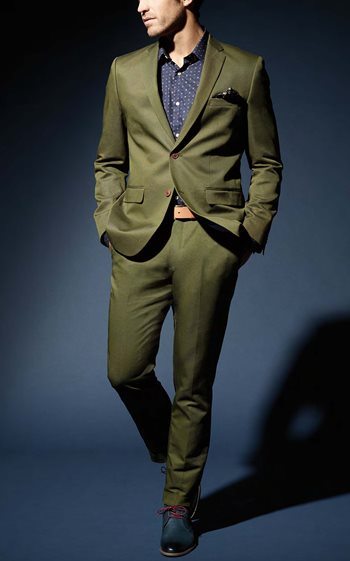
2 Bonus Tips
Olive Green SuitBonus Tip #1: Does it Complement Your Body Type?
There are two ways that this is properly done other than having a bespoke suit.
- Make sure that the suit jacket, blazer, or sports coat is tailored to fit you. Take the time out to contact a good tailor to ensure that the jacket is the proper fit in the side, sleeve length, and width, and shoulder placement.
- The waistband is comfortable and the correct size and the pant leg doesn’t have too much break (bunch up over the shoe excessively). This can be corrected via a tailor as well. It is a severe no-no to have your wait too big and bunching up when you put your belt on. A belt is to secure that your pants stay in place, not keep pants that are too big up. By getting your pant leg properly hemmed, it keeps the legs looking long and sleek. The modern trend is to have a little sock showing when you stand so make sure your socks are great. If that’s not at your comfort level, a slight break over the top of your shoe (1/4 -1/3 of an inch) would suffice.
Remember, the overall look of a suit without a necktie might be daunting to some, but no one can deny a well fitting suit is a fantastic representation of a man.
Bonus Tip #2: Maintain Your ? Hair (If applicable)
People’s eyes, when they notice an outfit, start at the face so have a good presentation. Whether you have ? hair or not, don’t set yourself up for further scrutiny by not being well groomed. If you have a mustache or beard, make sure it’s neat and crisp.
Remember, it’s all about confidence and comfort. If you’re going to wear a suit without a tie, make sure you own it so you can own the room!
- Pocket square – As a generalization, the eyes draw to the face then downward. As such the pocket square is vital to keep the tieless suit as refined as possible. Many gents forego this critical accessory because they simply don’t know how to sport it. It’s really simple. Just get a plain white kerchief or pocket square, make a straight fold, and place it in your pocket with about ¼ to ½ an inch of the pocket square exposed. The compliments will be through the roof gents. Trust me!
-
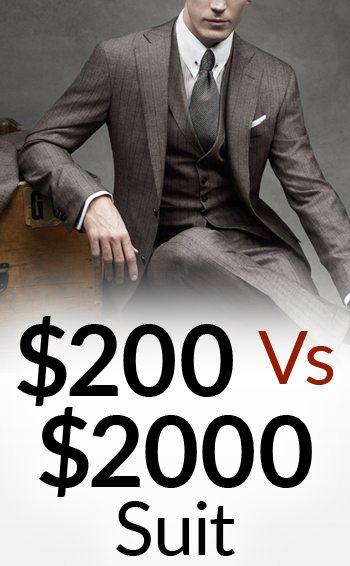
http://www.realmenrealstyle.com/200-vs-2000-suit/
A $200 suit vs a $2,000 suit?
Is it really worth the difference?
You may be a young professional heading into a sales job.
Or you might be shopping for a wedding suit.
Eventually, you will have to decide what suit to get and at what price point.
So what is the difference?
The real answer?
There’s not one exact price point that is correct.
Most suits fall under a broad range of prices, so it’s up to you to spot the differences.
You need to find the suit that fits your budget at the best quality possible.
Knowing the details of low vs high-quality suits will help you make a smart purchasing decision.
So what are the differences?
This article is going to cover the 5 main distinctions in a lower end vs higher end suit.https://www.youtube.com/watch?v=-0AQ_JtIHxc
Low Vs High-Quality Suit Explained
Indicator 1 – Suit Design
$200: Mass Produced To Fit Majority Of Market, Baggier Fit That is Made To Be Tailored
Suits that are in the lower price ranges often times are created for the largest available market thus more suits are produced. These are known as “Off-The-Rack ” or “Ready to Wear”.
As a business, it’s important that the fitting of the suits be less tailored to appeal to the masses. It’s at the discretion of the consumer to get the suit fitted by a third party tailor.
$2000: Made To Hug The Body like A Second Skin
Suits in this price range are generally for those gentlemen who are really particular about the fit. When you enter a high-end menswear store and are looking to purchase a suit at this price point, often times they can be found in two categories:
-
Semi-customizable/made-to-measure – Suits in this category are already pre-constructed. The fabric has been chosen and the suit jacket and trousers have already been made. What makes it semi-customizable is that the stitching is not permanent. It’s stitched with a loose thread that is meant to be replaced with a permanent stitch after the blazer and trousers have been fully fitted to your frame.
Bespoke/custom – Suits in this category are fully customized. This suit is bespoke which means that measurements of your neck, length, and circumference of your arms, the width of your thigh, etc. are taken so that the suit fits perfectly are kept . You are literally measured from neck to ankle. Next, the style of suit is chosen. Things like if it’s single or double breasted or how high you want the arm holes in the jacket. Finally, the consumer chooses the fabric and the minor details such as the color and material of the buttons or the type of pocket.
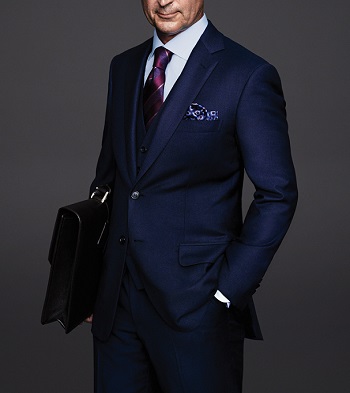
Indicator 2 – Suit Fabric
$200: Polyester, Rayon, Cotton Blends, Recycled Wool & Synthetic Blends
The type of fabric is critical to suiting. With fabric, you generally get what you pay for. Manufacturing these suits using the fabrics listed above is relatively inexpensive so the clothing line and/or the menswear store doesn’t have to mark up the price exorbitantly high to make a profit.
Additionally, the fabrics in this price range will lose shape over time. This affects the overall aesthetic of the suit. It becomes loose, begins to drape, and starts pilling. Pilling occurs when the fibers in a fabric or garment rub together, causing them to break off and accumulate in small piles or ? .
$2000: 100% ? Wool, Rich Luster, Memorable Drape
Wool is the premier fabric for a suit. It’s durable and can be manufactured with great patterns that are rich and long lasting. Wool comes from sheep and is more difficult and labor intensive to harvest than cotton and synthetic blends.
The time and care it takes to raise and care for sheep as well as sheer them comes at a premium cost. Other major benefits of wool fabric are:
-
Wool is naturally water resistant an stays dry while absorbing humidity
This fabric is resistant to static electricity
Wool is extremely durable. As long as the thread is tight, wool suits can be worn for many years without signs of wear
Naturally resistant to dirt
Easily maintains its original shape
Warm while also breathable, making it the ideal fabric for summer or winter
Perfect choice for those who have skin reactions to man-made materials
Indicator 3 – Suit Construction
$200: Machine Sewn with a Fused Lining
Remember, at this price point suits are mass produced and this is done via industrial sewing machines. This is a cost effective way of production. A pattern is put into the machine and the fabric is loaded. Then an operator pushes the start button. This process does not have the benefit of a trained eye scrutinizing every detail.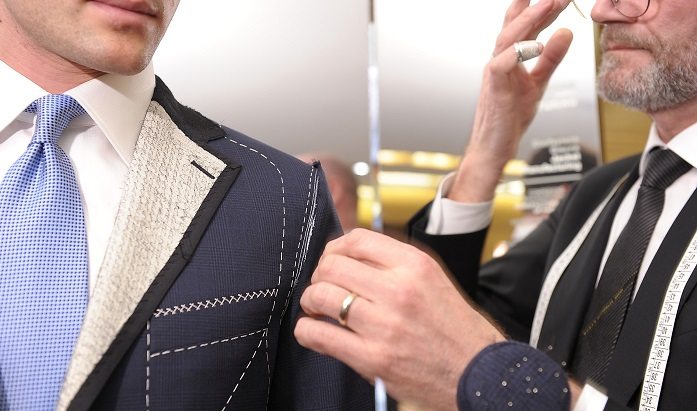
$2000: Hand-Stitched, Tailored Construction, Precision, and Durability in Sewing
At this level, the suits are usually hand stitched. The time and care of hand stitched merino wool suit all but guarantees quality. The tailor is able to make on the spot adjustments and watch for inconsistencies while created the garment.
He/she can also make sure that the amount of stitches per inch (at least 14) is adhered to. This strengthens the construction and durability of the fabric as it’s fused together. Another benefit of being hand stitched is that it can be tailored to fit your body type providing the most flattering look possible.
Indicator 4 – Service Before And After Purchase
$200: Most Associates Will be Untrained on True Quality. Returns Usually at a Service Desk
When you purchase off the rack you are met with a salesperson. They are strictly there to sell!
This is not necessarily a bad thing as business has to be conducted. What you run into, however, are sales persons who are not knowledgeable about the product. It can be a teenager that’s working a summer job or someone who is looking for supplemental income.
It can speak to a diminishing level of service. When there is a problem with the suit, you have to take it to customer service. Usually, the option is to return it or not is met with little to no remorse or options to remedy the situation. -
$200 vs $200 Suit con't
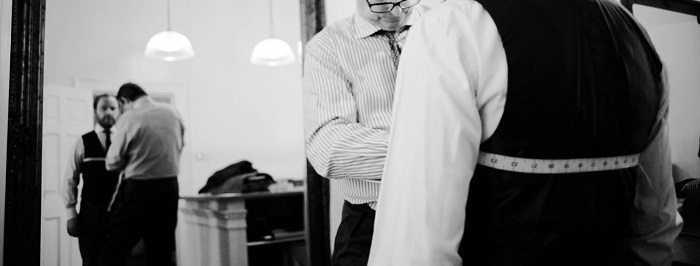
$2000: You’re Also Paying For an Experience. One on One Help From Highly Knowledgeable Associates
Included in the price of purchasing a well-made suit is the experience. You are generally met with knowledgeable stylists who happen to sell clothing. Yes, they are there to sell but they recognize that this purchase is an investment and want to show gratitude for you spending this amount of money. If you ever return for any reason the associate will usually greet you by your first name.
Whether you’re getting a bespoke suit or purchasing semi-customizable suit from a high-end store, the experience usually comes with the following:
• Personal stylist who is well versed in menswear and attends to your style needs
• Refreshments are offered to keep you comfortable during the measuring and purchasing process
• Sumptuous and classy environment that caters the unique tastes of their typical clientele.
• Problems are resolved with the client in mind. When there is an issue with the garment, the goal is to correct the garment as well as maintain a great relationship with the customer.
Indicator 5 – Suit Brand Reputation
$200: Fast-Fashion Department Store or No-Name Brand
The brand names that are synonymous with high-end quality don’t exist at this price point. Stores in this range are more concerned with turning over their inventory and having “no-name brand” suits that will allow a large amount of product to leave the store.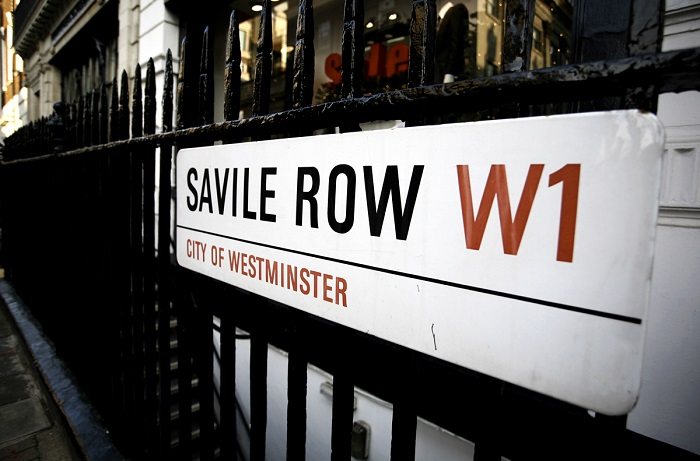
$2000: Usually a Heritage Brand or a Company with a Strong Reputation for Quality
Suits in this price range are from brands that have a long history of quality. Often times the material is sourced and manufactured from Italian mills. It’s easy to recognize them due to brand visibility.
Note: Pay attention to the quality of the marketing material in the stores. Brands that have strong reputations, as well as a history of well-made products, will have well thought out, high-quality posters and ads in the store. Marketing material that looks cheap and “low budget” is often an indicator of a less established brand that’s not known for quality. -
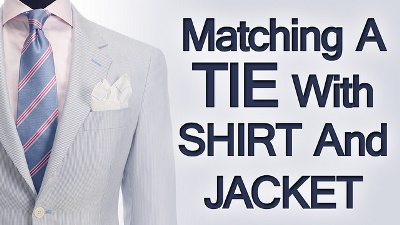
http://www.realmenrealstyle.com/matching-tie-shirt-jacket/
How would you define a sharp dressed man?
Is it by the how carefully groomed is hair is?
Possible how polished his shoes are?
Both of those are good indicators of man who is well put together……but let’s not leave out this defining style characteristic……
A sharp dressed man needs to be able to coordinate his necktie, shirt and jacket.
Ready to get better at it?
While this article does not go in-depth for matching specific ties to shirts and jackets (an encyclopedia would be needed for that!) you will learn the basics.
A solid foundation is all most men need to make smart decisions prior to purchasing clothing and mixing and matching what you already have.
Now let’s get down to business.
Watch the YouTube video: Matching a Tie with a Shirt and Jacket | 5 Rules on How to Match Items in Your Wardrobehttps://www.youtube.com/watch?v=sh1fwz_3-qk
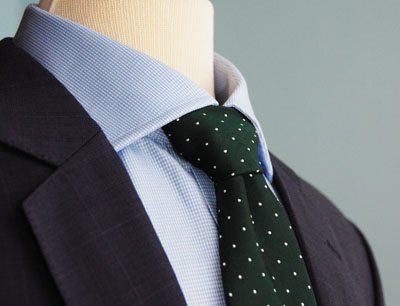
#1 The Tie Should Compliment the Shirt & Jacket
Purchasing a shirt and jacket to match the ties you currently own is not the smartest way to build a wardrobe.
That’s like installing your garage door to match the color of your lawnmower.
Instead focus on matching your accessories and shirt to your most expensive items (suits and jackets!) first and work your way down to items that cost less – such as your tie.
You should purchase the items in question in the following priority:
- Jackets/Suits – It doesn’t matter if it’s a blazer or sports jacket, this will probably be the most expensive item of the three. Aim to purchase your jacket in neutral, solid colors to avoid limiting what you can match it with. It is much easier matching a navy blue blazer than it would be a green one in a checkered pattern.
- Shirt – Your second investment should remain conservative with a little more wiggle room to experiment. You can’t go wrong with solid shirts in white and blue but you can begin incorporating pink, grey in subtle pinstripes.
- Tie – Ties can be expensive based on where they are made and the fabric used but you can purchase one for a low price. You can have fun showing off your personality with your ties but keep in mind the colors and patterns of your jacket and shirts first.
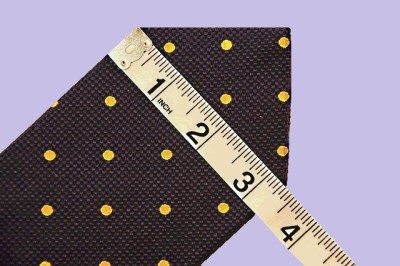
#2 Tie Proportions Tie Width
Ties come in many sizes and lengths.
However the width is where people will notice the difference – especially if the proportions are off.
As a general guide you want to ensure that your tie measures at around 3 to 3.5 inches in width or closely match the width of your lapel.
Anything larger and you run the risk of the tie looking too thick and taking prominence over the important areas of your outfit such as the jacket itself. Too thin and it makes you look large/like you’re wearing something trendy.
Another way to determine the measurements of your tie is the width of the lapels on your jacket. Your tie should closely resemble your lapels to ensure balanced proportions.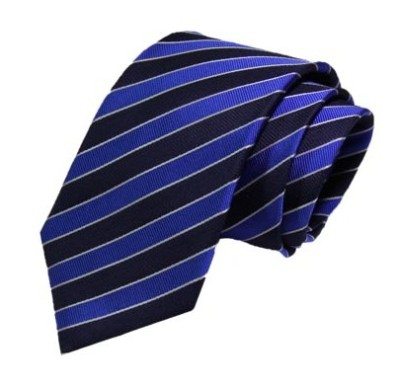
#3 Tie Pattern
If there was ever an article of clothing that thrives in different colors and patterns the tie would be it.
Options are a great thing for men but they can also create confusion.
Here is a small sample of the types of ties you can find at your local menswear store.- Dots
- Solids
- Small repeating patterns
- Stripes (from wide to thin)
- Paisley
For example – a blue pinstriped tie should not be worn with a blue pinstriped shirt with similar sized proportions. There would be no contrast and will blend together in an abnormal way that may cause the others to even see movement (where there is none!).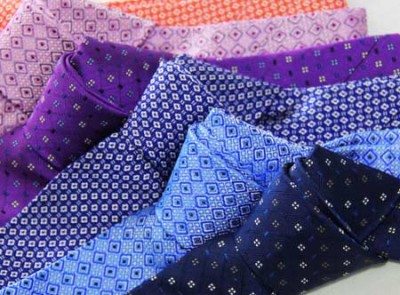
#4 Tie Colors
You can’t go wrong with sticking to colors with cooler tones such as deep blue, olive green and royal purple.
This will ensure that a wide range of your shirts and jackets pair up well assuming that they are light colored and simple in pattern.
If you would like to draw some additional attention to yourself this is where the warmer toned tie colors come into play.
Red, orange and yellow ties go well with a navy blue or charcoal suit which is a great pairing if you are giving a presentation or running a meeting.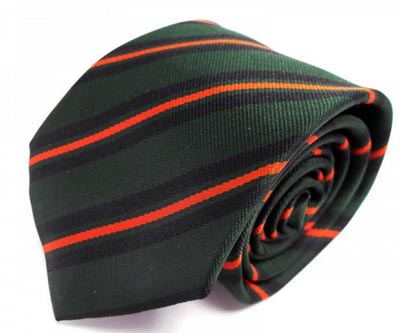
#5 Tie Fabric & Stylesbrigade-of-gurkhas-regimental-tie-400
With the amount of ties available today it’s no question why men get confused when trying to match up with their shirts and jackets.
There seems to be new types of ties cropping up everyday.
To eliminate the fluff, we have laid out 9 style of tie for you in order of importance and versatility you should consider purchasing in this detailed article here:
The 9 Necktie Styles Every Man Should Consider Buying & In Which Order To Buy.
When it comes to necktie fabrics and materials – here are the basics
- Silk Tie – A classic silk tie is the best style you can purchase. The luxurious feel of silk coupled with it’s recognition make it a top choice for men. The type of silk used can range from smooth to slightly stiff.
- Cashmere Tie – Second only to silk, this soft hair is know to actually be warmer than wool.
- Satin Tie – Satin fabric can be created with many fabrics that use the “satin weave”. Satin ties have a natural sheen to it that rivals silk at less the cost. However, the feel of a satin tie is a little more dull compared to silk or cashmere.
- Polyester Tie – A petroleum based fabric, polyester also is inspired by the luxury of silk but does fall short. Polyester ties are less expensive which can be seen as a plus for some shoppers.
- Jackets/Suits – It doesn’t matter if it’s a blazer or sports jacket, this will probably be the most expensive item of the three. Aim to purchase your jacket in neutral, solid colors to avoid limiting what you can match it with. It is much easier matching a navy blue blazer than it would be a green one in a checkered pattern.
-

The Perry Ellis Slim Fit Suit Jacket
-
It's crazy that some ? do need this type of help. My mother was a tailor so I stayed A-1 in suits
-
king hassan wrote: »It's crazy that some ? do need this type of help. My mother was a tailor so I stayed A-1 in suits
Cats don't fathers and therefore don't know about dressing properly. -
That's a blessing.king hassan wrote: »It's crazy that some ? do need this type of help. My mother was a tailor so I stayed A-1 in suits
i can count on one hand the time I've seen my popsnin a suit. And in southern ln LA some nice cowboy boots worn with slacks is "dressed up". Lol. Real Cajun
-
That's a blessing.king hassan wrote: »It's crazy that some ? do need this type of help. My mother was a tailor so I stayed A-1 in suits
i can count on one hand the time I've seen my popsnin a suit. And in southern ln LA some nice cowboy boots worn with slacks is "dressed up". Lol. Real Cajun
Man I already know about that cowboy boots and suits, them cats be clean. And cowboy boots not cheap at all, they will hit your pockets -
@cinco do you go to bespoke stores in the dfw? If so who do you recommend?
-
@Olorun22
Nah I'm not on that level yet! Most I've done is Suit Supply and have them tailor it to the T.
But That blog I was in was at an event at a bespoke retailer called "Q Clothier" so u may want to check them out







